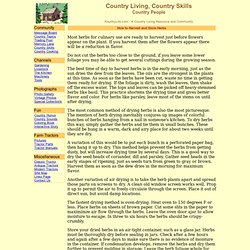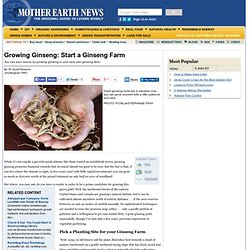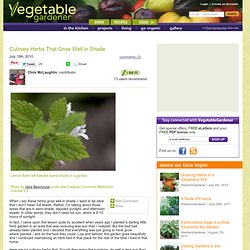

How To Harvest & Store Herbs. Most herbs for culinary use are ready to harvest just before flowers appear on the plant.

If you harvest them after the flowers appear there will be a reduction in flavor. Do not cut the herbs too close to the ground, if you leave some lower foliage you may be able to get several cuttings during the growing season. The best time of day to harvest herbs is in the early morning, just as the sun dries the dew from the leaves. The oils are the strongest in the plants at this time. As soon as the herbs have been cut, waste no time in getting them ready for drying. The most common method of drying herbs is also the most picturesque. A variation of this would be to put each bunch in a perforated paper bag, then hang it up to dry. Another variation of air drying is to take the herb plants apart and spread those parts on screens to dry.
The fastest drying method is oven-drying. Store your dried herbs in an air-tight container, such as a glass jar. Submitted by KP, WA [Home] [Search] Herb Culture & Use - Virginia Coop Extension. Introduction Most botanists would define an herb as a plant that dies back to the ground each year without forming woody stem tissue.

This definition limits the number of plants technically called herbs. Most gardeners include plants that have culinary, medicinal, aromatic, or ornamental uses. This definition would include lavender, rosemary, and bay, which form woody stems. Many families in the 18th and 19th centuries had their own herb gardens.
Herbs can be planted with vegetables or mixed in garden beds with annuals, perennials, shrubs, and trees. The classic use for herbs in the landscape is the formal garden. Site When selecting a site to plant your herbs, keep in mind that culinary herbs are native to the Mediterranean, Northern Europe, and Asia; therefore, the plant’s native habitat must be taken into consideration. Choose a soil that is fertile and loamy for best results. Prepare the soil to a depth of 8 inches.
Some tender perennials need protection from winter winds. Propagation. 40 Inspiring DIY Herb Gardens. If you love to cook you most likely can’t live without fresh herbs.

You can buy them when you need them but it would be much better if you will always have them in pots near by. This way it’s much easier to mix them in small doses and add in all meals you’re cooking. Of course to have them on your kitchen or right outside your kitchen door you need to organize a thoughtful herb garden that also looks great. We’ve gathered for you a bunch of cool ideas that might inspire you to do that. Enjoy! Herbs And Vegetables In Modern Planters Of Different Heights (via bhg) DIY Herbal Window Box (via bhg) DIY Colorful Vertical Garden On A Fence (via shelterness) DIY Recycled Seed Pots from Newspapers and Magazines (via shelterness) Container Herb Garden (via bhg) Growing Ginseng: Start A Ginseng Farm. Related Content Rambling Rose Ramblings A beautiful old, old, rambling rose bush that grows on my moms corner fence post greets us with pink...

Garlic Farming Video Watch this video of garlic farmer Bob Anderson discussing his love of all things garlic. While it's not exactly a get-rich-quick scheme like those touted on matchbook covers, growing ginseng promises financial rewards that do sound almost too good to be true. But where, you may ask, do you have to reside in order to be a prime candidate for growing this green gold? Pick a Planting Site for your Ginseng Farm Wild 'sang, as old-timers call the plant, flourishes best beneath a stand of mature hardwoods on a gentle northeast-facing slope that has thick, moist leaf litter and little undergrowth. Prepare Your Ginseng Bed Once you've located—or created—a promising area for cultivating your crop, you can go ahead and prepare the bed for it by first removing all undergrowth. Start Small and Plan Ahead when Growing Ginseng Pest Control Cost. Culinary Herbs That Grow Well In Shade. July 19th, 2010 Email 13 users recommend Lemon Balm will tolerate some shade in a garden.

Photo by Jess Beemouse under the Creative Commons Attribution License 2.0. When I say these herbs grow well in shade, I want to be clear that I don't mean full shade. In fact, I came upon this lesson quite by accident when years ago I planted a darling little herb garden in an area that was receiving less sun than I realized. Here are six culinary herbs that, though they enjoy the sunshine, do well in less sun than you may think. Shiso (Perilla frutescens) - This handy herb grows as an annual in all zones up to 3 feet tall. Aside from pulling their weight in the kitchen, these herbs can take the place of the more common stand-bys such a ivy in shady landscaping.
Posted in: herbs Get special offers, FREE eLetters and your FREE PDF bonus now. Find us on: